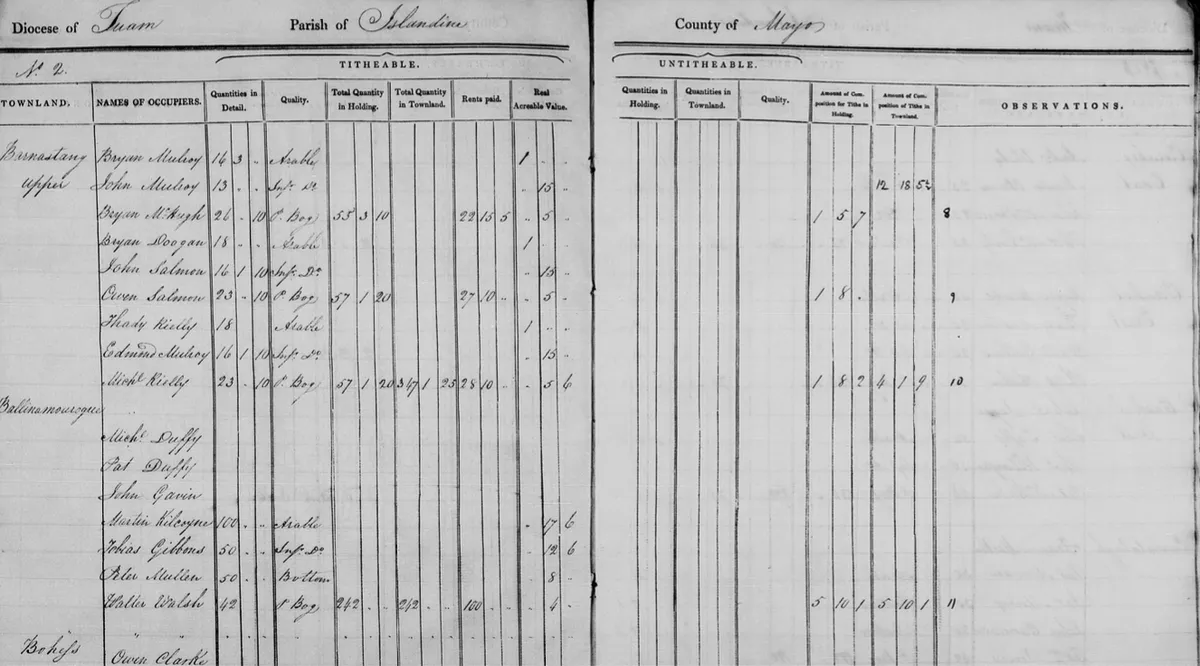What are tithe applotment books?
Tithe applotment books were records compiled in Ireland between 1823 and 1837 for the purpose of assessing the monetary rate of the tithe, a 10 per cent religious tax on the agricultural output of land in the country that was levied for the upkeep of the Church of Ireland. All of the agricultural lands in Ireland were surveyed and the name of the occupier, the size of their holding and the rate of the tithe were recorded.
Although they are not a comprehensive record of all households, the tithe applotment books are the earliest all-island source that documents occupiers of property in 19th century Ireland. If you've found an ancestor in Griffith's Valuation, you can try to trace them in the tithe applotment books a generation earlier.
Tracing Irish ancestry is difficult because many key records from the country are missing, including 19th century census records. Tithe applotment books are therefore an important Irish family history resource. However, there are a couple of limitations. Only the head of the household was recorded, so you won’t find other relatives. Also, the tithe was applied solely to agricultural land, which largely excludes urban areas and landless labourers and tradesmen.
Tithe applotment books are an important Irish family history resource.
There was also a tithe system for England and Wales, which led to the creation of tithe maps in the 1830s and 1840s.
Where to find tithe applotment books online
There are a variety of indexes and images of the tithe applotment books available online. Unlike other 19th century sources for Irish genealogy, the books have been divided between the Republic of Ireland and Northern Ireland.
For the Republic of Ireland (ROI) there is an index of names and places published at Ancestry in the collection ‘Ireland, Tithe Applotment Books, 1805–1837’. This index does not include the acreage, quality and valuation or other annotations from the original record. Half of the 26 counties for the ROI have been similarly indexed at RootsIreland. The tithe applotment records for County Cavan are available for free on Towns of Cavan.

The original tithe applotment books for the Republic of Ireland were microfilmed by the Church of Jesus Christ of Latter-day Saints, and the images are freely available to search and browse on FamilySearch. This same dataset was donated to the National Archives of Ireland where it can be freely accessed online. However, there are a significant number of errors in the tithe applotment books transcription. Parishes have been listed in the wrong county and there are some serious mistakes in the transcription of townland and personal names, which makes the search function very unreliable. Even accurate transcriptions of place names can pose problems, because their spelling was not standardised until the 1837 Ordnance Survey of Ireland. The use of wildcards is very much recommended, but the best approach is to browse the images for names and details.
For Northern Ireland there is an index for all six counties published at Roots Ireland where you can undertake an all-Ireland search or target a specific county. The Public Record Office of Northern Ireland (PRONI) has recently published digital images of the tithe applotment books for Northern Ireland, which can be accessed, via some complicated steps, through its online catalogue. A guide to accessing these digital images, with links, is available on Timeline Research. There is no option for a name search; researchers must instead download the book and browse for relevant entries manually.
The tithe applotment books were not exactly uniform, and the quality of information gathered varies. One book might only record the landlord as the tithe payer, while another may contain detailed notes on each occupier. The common terms “& Co.” and “& partners” do not refer to a business arrangement, but to a group of tenants farming common land. Occasionally, the occupiers of urban property were enumerated and one surveyor recorded the trade or profession of each individual in a town.
Some of the books include townland maps. There are also parishes for which the books do not survive. It is worth taking the time to fully investigate what details were recorded for your ancestor’s parish.

The tithe was a very unpopular tax because it was levied on Catholics for the support of a church to which they did not belong. Farmers began withholding their tithe payments in 1830, and as this movement gained momentum there were outbreaks of violent conflict between tenants, Tithe collectors and clergymen. The ‘Tithe War’ was ended by the 1838 Tithe Commutation Act, which transferred the burden of the Tithe from tenant farmer to landlord. Findmypast has a list of more than 29,000 Tithe defaulters for this period.
